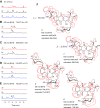Divergent non-heme iron enzymes in the nogalamycin biosynthetic pathway
- PMID: 27114534
- PMCID: PMC4868444
- DOI: 10.1073/pnas.1525034113
Divergent non-heme iron enzymes in the nogalamycin biosynthetic pathway
Abstract
Nogalamycin, an aromatic polyketide displaying high cytotoxicity, has a unique structure, with one of the carbohydrate units covalently attached to the aglycone via an additional carbon-carbon bond. The underlying chemistry, which implies a particularly challenging reaction requiring activation of an aliphatic carbon atom, has remained enigmatic. Here, we show that the unusual C5''-C2 carbocyclization is catalyzed by the non-heme iron α-ketoglutarate (α-KG)-dependent SnoK in the biosynthesis of the anthracycline nogalamycin. The data are consistent with a mechanistic proposal whereby the Fe(IV) = O center abstracts the H5'' atom from the amino sugar of the substrate, with subsequent attack of the aromatic C2 carbon on the radical center. We further show that, in the same metabolic pathway, the homologous SnoN (38% sequence identity) catalyzes an epimerization step at the adjacent C4'' carbon, most likely via a radical mechanism involving the Fe(IV) = O center. SnoK and SnoN have surprisingly similar active site architectures considering the markedly different chemistries catalyzed by the enzymes. Structural studies reveal that the differences are achieved by minor changes in the alignment of the substrates in front of the reactive ferryl-oxo species. Our findings significantly expand the repertoire of reactions reported for this important protein family and provide an illustrative example of enzyme evolution.
Keywords: Streptomyces; crystal structure; iron-dependent oxygenase; natural product biosynthesis; α-ketoglutarate–dependent oxygenase.
Conflict of interest statement
The authors declare no conflict of interest.
Figures









References
-
- Metsä-Ketelä M, Niemi J, Mäntsälä P, Schneider G. In: Anthracycline Chemistry and Biology I: Biological Occurrence and Biosynthesis, Synthesis and Chemistry. Krohn K, editor. Springer; Berlin: 2008. pp. 101–140.
-
- Weiss RB. The anthracyclines: Will we ever find a better doxorubicin? Semin Oncol. 1992;19(6):670–686. - PubMed
-
- Arora SK. Molecular structure, absolute stereochemistry, and interactions of nogalamycin, a DNA-binding anthracycline antitumor antibiotic. J Am Chem Soc. 1983;105(5):1328–1332.
Publication types
MeSH terms
Substances
Associated data
- Actions
- Actions
- Actions
- Actions
- Actions
LinkOut - more resources
Full Text Sources
Other Literature Sources
Medical
Miscellaneous

